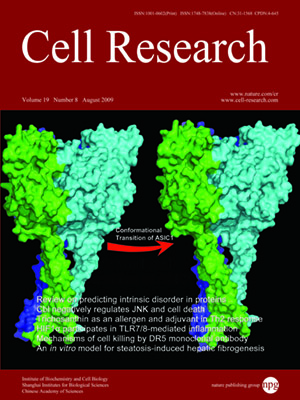
Volume 19, No 8, Aug 2009
ISSN: 1001-0602
EISSN: 1748-7838 2018
impact factor 17.848*
(Clarivate Analytics, 2019)
Volume 19 Issue 8, August 2009: 984-995
ORIGINAL ARTICLES
An agonistic monoclonal antibody against DR5 induces ROS production, sustained JNK activation and Endo G release in Jurkat leukemia cells
Caifeng Chen, Yanxin Liu and Dexian Zheng
National Laboratory of Medical Molecular Biology, Institute of Basic Medical Sciences, Chinese Academy of Medical Sciences & Peking Union Medical College, 5 Dong Dan San Tiao, Beijing 100005, China
Correspondence: Dexian Zheng,(zhengdx@pumc.edu.cn or zhengdx@tom.com)
We have previously reported that AD5-10, a novel agonistic monoclonal antibody against DR5, possessed a strong cytotoxic activity in various tumor cells, via induction of caspase-dependent and -independent signaling pathways. The present study further demonstrates that reactive oxygen species (ROS) were generated in abundance in Jurkat leukemia cells upon AD5-10 stimulation and that ROS accumulation subsequently evoked sustained activation of c-Jun N-terminal kinase (JNK), loss of mitochondrial membrane potential, and release of endonuclease G (Endo G) from mitochondria into the cytosol. The reducing agent, N-acetylcysteine (NAC), effectively inhibited the sustained activation of JNK, release of Endo G, and cell death in Jurkat cells treated by AD5�10. Moreover, a dominant-negative form of JNK (but not of p38) enhanced NF-B activation, suppressed caspase-8 recruitment in death-inducing signaling complexes (DISCs), and reduced adverse effects on mitochondria, thereby inhibiting AD5-10-induced cell death in Jurkat leukemia cells. These data provide novel information on the DR5-mediated cell death-signaling pathway and may shed new light on effective strategies for leukemia and solid tumor therapies.
We have previously reported that AD5-10, a novel agonistic monoclonal antibody against DR5, possessed a strong cytotoxic activity in various tumor cells, via induction of caspase-dependent and -independent signaling pathways. The present study further dem
FULL TEXT | PDF
Browse 2160


